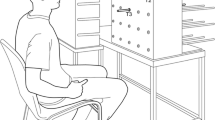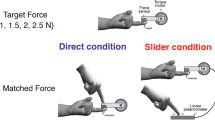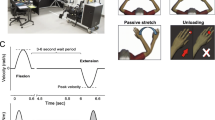Abstract
Increasing evidence indicates that processing of proprioceptive information is altered in Parkinson’s disease (PD), leading to reduced kinaesthetic and haptic sensitivity. However, there is inconclusive evidence whether dopamine replacement therapy (DRT) ameliorates or worsens kinaesthetic and haptic function in PD. For assessing perceptual function, we employed a task that did not require active motion or stressed working memory function, which may become impaired in PD. A group of mild to moderate stage PD patients (n = 9) and a group of age-matched healthy controls participated in this study. Without vision, a subject’s hand was moved by a robotic manipulandum along the contours of a small “virtual box” (5 × 15 cm). At the end of each trial, they indicated whether the contour was “curved” or “straight”. PD patients were tested ON and OFF antiparkinsonian medication. Psychophysical detection thresholds were determined (curvature at which subjects correctly perceived a curved contour at the 75% level). Compared to the control group, thresholds were elevated by 55% in the PD patient group. During the ON medication state, the mean detection threshold of the patient group was reduced by 15% (ON: 4.71 m−1; OFF: 5.42 m−1). Increases in curvature sensitivity were highly correlated with improved clinical scores of motor function (r = 0.74) with more affected patients showing higher gains in sensitivity as the result of DRT (r = 0.80). This report documents that DRT can ameliorate haptic and kinaesthetic function in patients with mild to moderate PD, suggesting that DRT can have beneficial effects on perceptual function.



Similar content being viewed by others
References
Abbruzzese G, Berardelli A (2003) Sensorimotor integration in movement disorders. Mov Disord 18:231–240
Adamovich SV, Berkinblit MB, Hening W, Sage J, Poizner H (2001) The interaction of visual and proprioceptive inputs in pointing to actual and remembered targets in Parkinson’s disease. Neuroscience 104:1027–1041
Benecke R, Rothwell JC, Dick JP, Day BL, Marsden CD (1987) Disturbance of sequential movements in patients with Parkinson’s disease. Brain 110(Pt 2):361–379
Boraud T, Bezard E, Bioulac B, Gross CE (2000) Ratio of inhibited-to-activated pallidal neurons decreases dramatically during passive limb movement in the MPTP-treated monkey. J Neurophysiol 83:1760–1763
Clissold BG, McColl CD, Reardon KR, Shiff M, Kempster PA (2006) Longitudinal study of the motor response to levodopa in Parkinson’s disease. Mov Disord 21:2116–2121
Crutcher MD, DeLong MR (1984) Single cell studies of the primate putamen. I. Functional organization. Exp Brain Res 53:233–243
Crutcher MD, DeLong MR (1984) Single cell studies of the primate putamen. II. Relations to direction of movement and pattern of muscular activity. Exp Brain Res 53:244–258
DeLong MR, Crutcher MD, Georgopoulos AP (1985) Primate globus pallidus and subthalamic nucleus: functional organization. J Neurophysiol 53:530–543
Diamond SG, Schneider JS, Markham CH (1987) Oral sensorimotor defects in patients with Parkinson’s disease. Adv Neurol 45:335–338
Fahn S (1999) Parkinson disease, the effect of levodopa, and the ELLDOPA trial. Earlier vs Later l-DOPA. Arch Neurol 56:529–535
Fechner GT (1889) Elemente der Psychophysik. Breitkopf & Härtel, Leipzig
Filion M, Tremblay L, Bedard PJ (1988) Abnormal influences of passive limb movement on the activity of globus pallidus neurons in parkinsonian monkeys. Brain Res 444:165–176
Folstein MF, Folstein SE, McHugh PR (1975) Mini-mental state. A practical method for grading the cognitive state of patients for the clinician. J Psychiatr Res 12:189–198
Herting B, Schulze S, Reichmann H, Haehner A, Hummel T (2008) A longitudinal study of olfactory function in patients with idiopathic Parkinson’s disease. J Neurol 255:367–370
Jobst EE, Melnick ME, Byl NN, Dowling GA, Aminoff MJ (1997) Sensory perception in Parkinson disease. Arch Neurol 54:450–454
Klockgether T, Borutta M, Rapp H, Spieker S, Dichgans J (1995) A defect of kinesthesia in Parkinson’s disease. Mov Disord 10:460–465
Konczak J, Corcos DM, Horak F, Poizner H, Shapiro M, Tuite P, Volkmann J, Maschke M (2009) Proprioception and motor control in Parkinson’s Disease. J Mot Behav 41(6):543–552
Konczak J, Krawczewski K, Tuite P, Maschke M (2007) The perception of passive motion in Parkinson’s disease. J Neurol 254:655–663
Konczak J, Li KY, Tuite PJ, Poizner H (2008) Haptic perception of object curvature in Parkinson’s disease. PLoS One 3:e2625
Kulisevsky J (2000) Role of dopamine in learning and memory: implications for the treatment of cognitive dysfunction in patients with Parkinson’s disease. Drugs Aging 16:365–379
Maschke M, Gomez CM, Tuite PJ, Konczak J (2003) Dysfunction of the basal ganglia, but not the cerebellum, impairs kinaesthesia. Brain 126:2312–2322
Maschke M, Tuite PJ, Krawczewski K, Pickett K, Konczak J (2006) Perception of heaviness in Parkinson’s disease. Mov Disord 21:1013–1018
Maschke M, Tuite PJ, Pickett K, Wachter T, Konczak J (2005) The effect of subthalamic nucleus stimulation on kinaesthesia in Parkinson’s disease. J Neurol Neurosurg Psychiatry 76:569–571
Mesholam RI, Moberg PJ, Mahr RN, Doty RL (1998) Olfaction in neurodegenerative disease: a meta-analysis of olfactory functioning in Alzheimer’s and Parkinson’s diseases. Arch Neurol 55:84–90
Mongeon M, Blanchet P, Messier J (2009) Impact of Parkinson’s disease and dopminergic medication on proprioceptive processing. Neuroscience 158:426–440
Muhlack S, Woitalla D, Welnic J, Twiehaus S, Przuntek H, Muller T (2004) Chronic levodopa intake increases levodopa plasma bioavailability in patients with Parkinson’s disease. Neurosci Lett 363:284–287
Nagy A, Eordegh G, Paroczy Z, Markus Z, Benedek G (2006) Multisensory integration in the basal ganglia. Eur J Neurosci 24:917–924
O’Suilleabhain P, Bullard J, Dewey RB (2001) Proprioception in Parkinson’s disease is acutely depressed by dopaminergic medications. J Neurol Neurosurg Psychiatry 71:607–610
Oldfield RC (1971) The assessment and analysis of handedness: the Edinburgh inventory. Neuropsychologia 9:97–113
Putzki N, Stude P, Konczak J, Graf K, Diener HC, Maschke M (2006) Kinesthesia is impaired in focal dystonia. Mov Disord 21:754–760
Robertson LT, Hammerstad JP (1996) Jaw movement dysfunction related to Parkinson’s disease and partially modified by levodopa. J Neurol Neurosurg Psychiatry 60:41–50
Rodriguez-Oroz MC, Rodriguez M, Guridi J, Mewes K, Chockkman V, Vitek J, DeLong MR, Obeso JA (2001) The subthalamic nucleus in Parkinson’s disease: somatotopic organization and physiological characteristics. Brain 124:1777–1790
Sathian K, Zangaladze A (1997) Tactile learning is task specific but transfers between fingers. Percept Psychophys 59:119–128
Tucha O, Mecklinger L, Thome J, Reiter A, Alders GL, Sartor H, Naumann M, Lange KW (2006) Kinematic analysis of dopaminergic effects on skilled handwriting movements in Parkinson’s disease. J Neural Transm 113:609–623
Tunik E, Feldman AG, Poizner H (2007) Dopamine replacement therapy does not restore the ability of Parkinsonian patients to make rapid adjustments in motor strategies according to changing sensorimotor contexts. Parkinsonism Relat Disord 13:425–433
Zia S, Cody F, O’Boyle D (2000) Joint position sense is impaired by Parkinson’s disease. Ann Neurol 47:218–228
Author information
Authors and Affiliations
Corresponding author
Rights and permissions
About this article
Cite this article
Li, Ky., Pickett, K., Nestrasil, I. et al. The effect of dopamine replacement therapy on haptic sensitivity in Parkinson’s disease. J Neurol 257, 1992–1998 (2010). https://doi.org/10.1007/s00415-010-5646-9
Received:
Revised:
Accepted:
Published:
Issue Date:
DOI: https://doi.org/10.1007/s00415-010-5646-9




